Following Detroit, I flew to Washington DC, meeting up with my friend Tara for a weekend exploring the capitol. This is the second in a series of posts about my East Coast US trip in March 2013 (see the first part here).

As my sole day in Detroit wound to a close, I chilled with Patrick and Elizabeth at their apartment before heading back to the airport. This was my second flight with Delta Airlines and it would take me to Baltimore Airport, from which I would transit to Washington DC. Unfortunately, this flight again struck problems. Just after our scheduled departure time, the captain announced that a fuel leak had been found in the right wing. The mandated test for this is to let it leak for a certain period of time to determine if the leak is within standard bounds (yes, seriously), so we sat on the plane and waited. Once the time was up, the captain returned to tell us that the right wing fuel leak had abated, but_ another_ fuel leak had been found in the left wing. The whole process repeated itself, and by the time the left leak was declared as being nonthreatening we were an hour late again.
Touching down in Baltimore, I sprinted through the terminal to make a bus connection. Baltimore is approximately 40 minutes from DC via public transport. I had hoped to be early in order to catch the more direct train, but the flight problems put paid to that. Instead, I had to make do with a bus service to the outer stations of Washington's metro line, switching onto the metro to reach my hotel near Union Station. A light rain was falling as we pulled in, and I grabbed a late dinner before heading to the hotel.
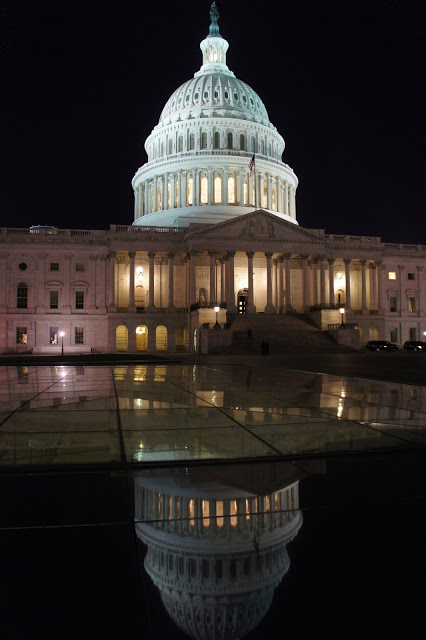
I was in DC alone for the first night, as Tara would not arrive until the next morning. Having nothing better to do, I departed the hotel around 11pm for a walk around the city. I guessed that there would be interesting things to take photos of, and I was not disappointed. The hotel was just down the street from the US Capitol Building, and I walked up the hill towards it happily snapping away. By now the rain had faded away, leaving the ground wet but the sky dry. However, the bitter cold of Detroit was still present in DC; my hands strayed out of their gloves only when necessary for camera manipulation; and I was well wrapped against the chill.
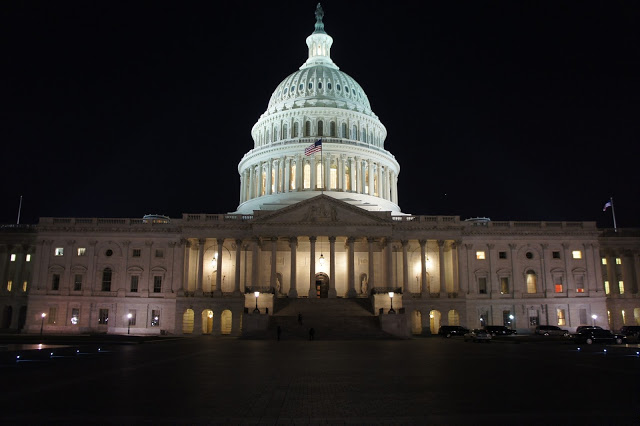
The US Capitol is truly impressive. Whilst I had seen something of its general design before at the Utah State Capitol building, the real thing was far grander. The dome is floodlit from below and shines brightly in the night, giving perfect views from all sides. As expected, there is ample security, and you cannot get close to any of the staircases into the building. Just behind the Capitol is the Supreme Court and the Library of Congress, but neither were lit up, and the Court was wreathed in scaffolding that put paid to any picture opportunities.

On the opposite side of the Capitol building to the Supreme Court is the National Mall, a long strip of grass separating roads leading down to the iconic Washington Monument. Many of the museums of the Smithsonian Institute line the Mall, making it one of the most concentrated areas of human knowledge and history in the world. It was extremely quiet here at this late hour, meaning a pristine environment for long exposure photography. I took the above shot with my NEX-5 at ISO 200, F16 aperture, and a 25 second exposure.

I finally finished taking photos at the Capitol, and decided to walk down nearby Pennsylvannia Ave to number 1600, i.e. the White House. I was hoping that it would be similarly spectacular. Along the way are many notable buildings; several more of the Smithsonian Institute, the Newseum Museum of News, and the J. Edgar Hoover building, headquarters of the Federal Bureau of Investigation. The Hoover building is a unsightly monolith of grey concrete, whilst the museum buildings were more tasteful decorated in the stone column style.
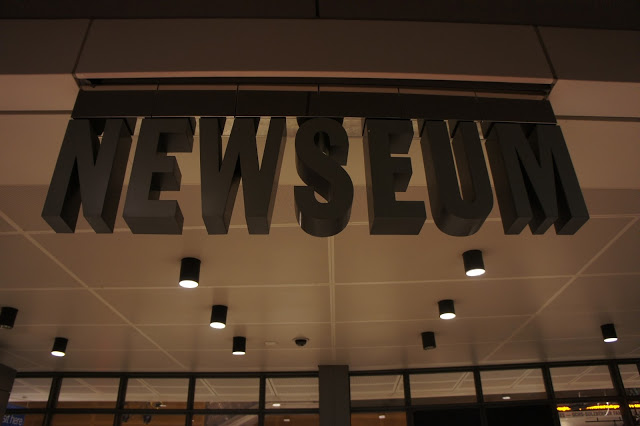
Unfortunately, by the time I completed the three kilometre walk to the White House, I was starkly reminded that it is actually a residence as well as a tourist attraction; the only thing lit up was the American flag flying from its roof. I managed to snag the above shot using my camera's Twilight mode: it takes six shots at a relatively fast shutter speed and high ISO, and combines them into one image. This has the advantage of not requiring a tripod for night shooting, though the pictures it produces aren't quite as clean. Thus defeated, I trouped back to the hotel to await the next day and better sightseeing opportunities.
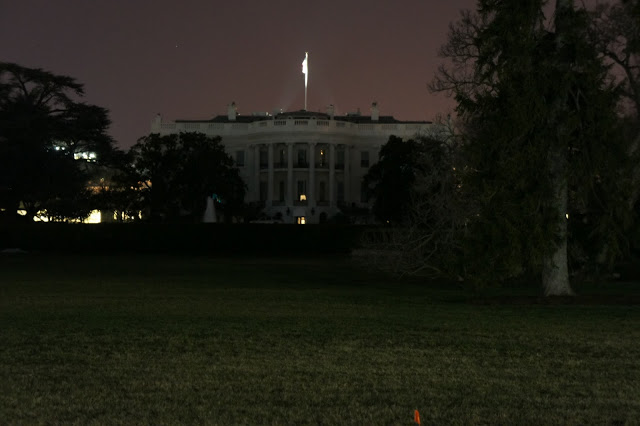
Tara arrived early the next morning, and following breakfast we set out on our first appointment: a tour inside the Capitol building. We had prebooked tickets online (you can do so from the Capitol Visitor website, or your local Congressional representatives). The day had dawned in glorious sunshine, and we enjoyed walking around under the beautiful blue skies. There was an extremely long security line at the Capitol Visitor Centre (just behind the building itself), but the line moved reasonably quickly and we were inside in about 20 minutes. The tour staging area is known as Emancipation Hall, and it is an enormous underground room typically filled with hundreds of people beginning, proceeding through, and finishing tours. Unfortunately, the slow security line meant that we had missed out scheduled tour time, but it was an easy thing to go up to the prebooked ticket desk and have a new time scheduled almost immediately.

The first stop of the tour was a theatre where we were shown an introductory video on the Capitol and Congress. Themed "We the people", the opening statement of the US Constitution, the video sketched a history of the democratic process in the United States. Unfortunately, in the context of today's hostile and partisan Congressional atmosphere, some of the video's message on compromise felt a bit forced. However, it still did a fine job conveying the spirit in which the world's leading democracy styles its representative system.
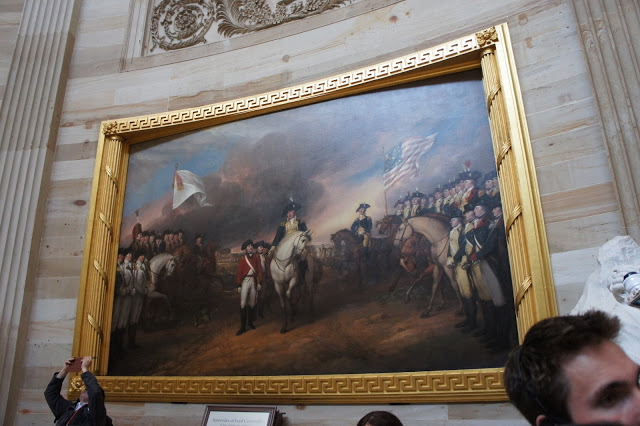
Following the video, we proceeded out of the theatre and into the subterranean levels deep under the Capitol Dome. Originally, the remains of George Washington were to be housed in a vault here, but his will stipulated that he wished to be buried at his home in Mount Vernon. To this day, the vault remains empty and is unlikely to be filled. Here we also saw the first of the many, many statues that line the halls and rooms of the Capitol. Each state was asked to donate two statues to the national collection that honoured notable persons in their history; the resulting collection is an eclectic mix of presidents, patriots, activists, astronauts, and more.
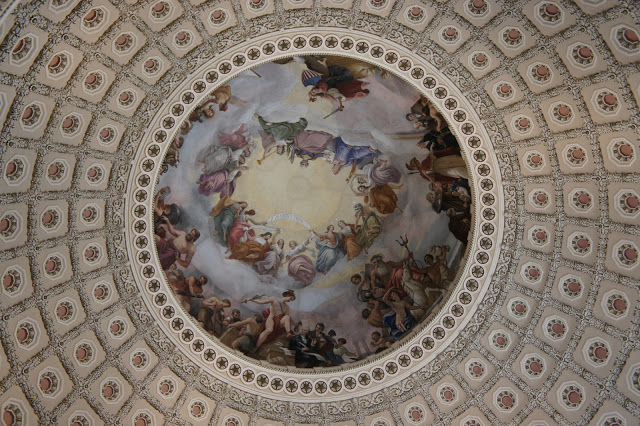
Next, we climbed upstairs and into the wide Capitol Rotunda underneath the dome. Important ceremonial events take place in here, including the lying in state of notable citizens, or the dedication of a new work of art. The rotunda is gloriously decorated. featuring enormous artworks of major elements of American history, more statues from the national collection, and a fresco timeline of the development of America. Several large cracks in the wall also featured; these were remnants of the damage done by a 2011 earthquake measuring 5.8 on the Richter scale. The dome itself rises 88m tall, and is a cast iron structure that replaced an earlier, smaller, and wooden dome. Completed during the Civil War, President Lincoln viewed the progress of the dome as a sign that the Union would hold strong and rise again. The underside of the dome is decorated with a fresco entitled "The Apotheosis of Washington"; it features George Washington (upside down in the above photo) rising to glory flanked by Liberty and Victory. Other figures in the fresco include Benjamin Franklin, Samuel Morse, and figures of War, Science, Marine, Commerce, Mechanics, and Agriculture, symbolising the development and pride of the fledgling nation.
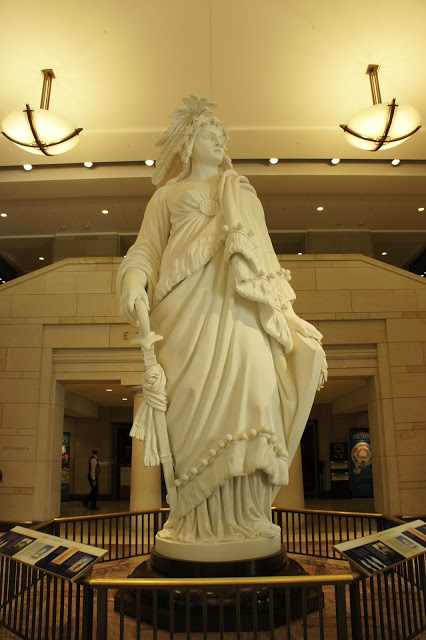
On top of the Capitol building is a distinct greenish statue. It is the six-metre tall Freedom; a woman cast in bronze bearing a sheathed sword in one hand and a laurel wreath in the other. At her base on the building is a half globe bearing a national motto, E pluribus unum - "Out of many, one". The original plaster cast of the statue, designed by Thomas Crawford in his studio in Rome, is on display in Emancipation Hall for visitors to see up close in all its glory. It doesn't look all that large standing on top of the dome, but it is very tall in person, reminding you of the wonders of perspective and distance.
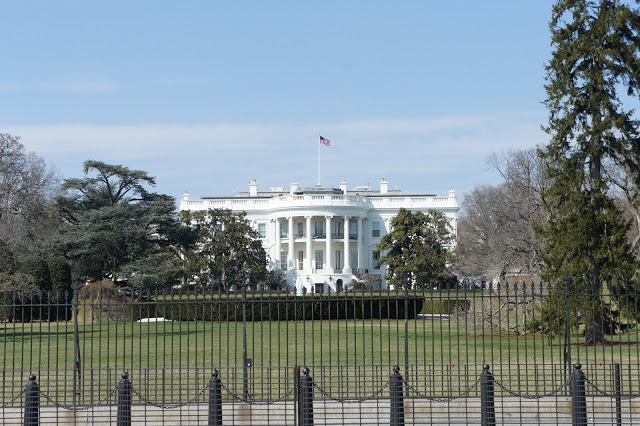
We were getting hungry as we finished at Congress, so we retraced my steps from the previous night to head towards the White House and the nearby Old Ebbitt Grill. The Grill is a restaurant and an oyster bar that's situated about as close as you can get to the White House without scaling a fence. It's been around for over 150 years, and once upon a time was popular with Presidents, including Teddy Roosevelt. Today the crowd is more touristy (with the occasional political staffer or journalist), but the Grill still serves a pretty mean eggs with crabcakes for brunch. Thus sated, we strolled over to perhaps the most famous residence in the world, now lit by the beautiful sunshine of a spring afternoon.
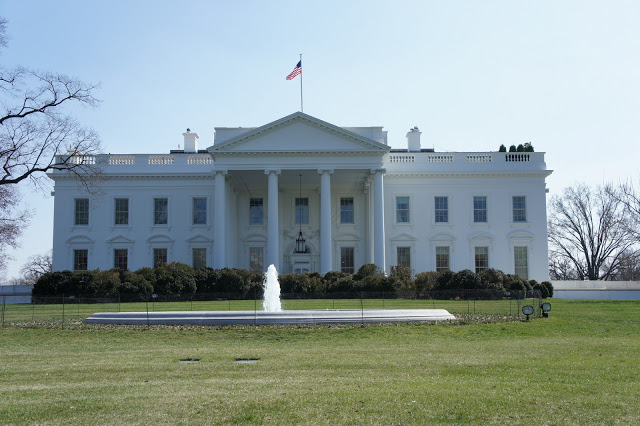
There is something glorious about seeing the White House in person. Stately it stands, the symbol of US executive power and influence the world over. Hoards of tourists at front and back crowd to take photos with the famous residence, with guards keeping a very watchful eye on everyone. Unfortunately, I was bitterly disappointed to find that while tours used to be offered for the building, these have been suspended in the light of sequestration budget cuts. Additionally, President Obama was not in town whilst we were in Washington DC; at the time he was still in the Middle East en route back home.
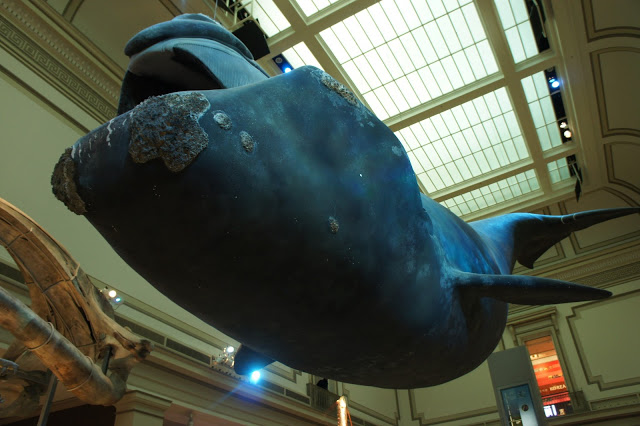
When the British scientist James Smithson died in 1829, he left most of his wealth to a nephew. But since the nephew died without children in 1835, the bulk of his uncle's estate passed on "to the United States of America, to found at Washington, under the name of the Smithsonian Institution, an Establishment for the increase & diffusion of knowledge among men." Today, the Smithsonian Institute holds 130 million items of artistic, historic, anthropological, architectural, and natural significance. Centred in Washington, visitors to its 19 museums are admitted without charge. After the White House we wandered past the Washington Monument and up to the nearby Natural History Museum of the Smithsonian. It is an incredible place, allowing you to stroll all corners of the globe underneath its green dome. There's a giant blue whale swimming above the ocean section, a huge elephant under the dome, and countless other treasures scattered through the halls.
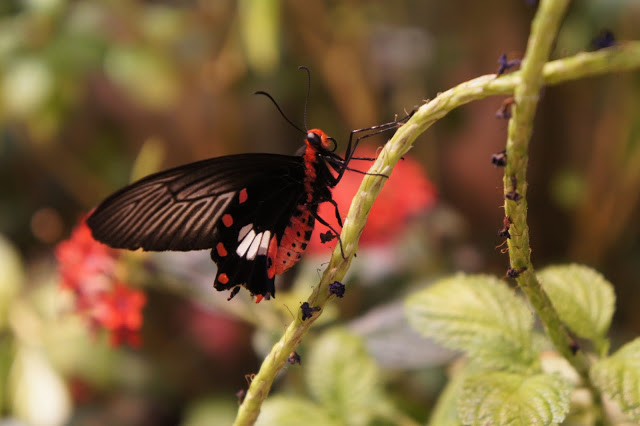
One of the most spectacular exhibits in the Natural History Museum was the butterfly enclosure. Well worth the cost of the addition ticket, it is a plant-filled room teeming with butterflies of all species. Riotously colourful, the butterflies swoop and flutter freely, around and over you, with mist jets keeping the atmosphere comfortable and feeding stations providing fruit and nectar to sate the insects. I had a good time practicing some macro photography (like the above photo) along the way.
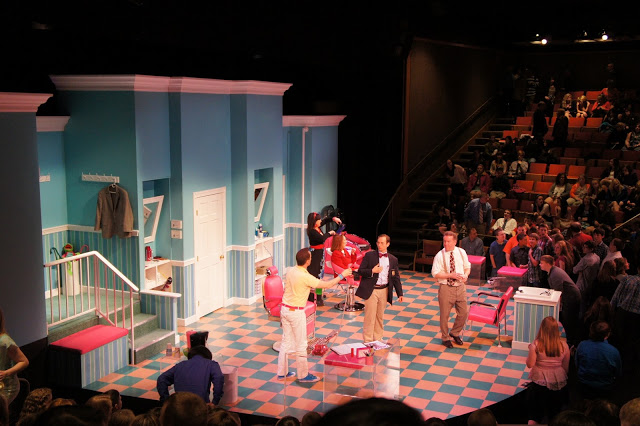
Our final stop for the day was the Kennedy Center for the Performing Arts. Both a memorial to President John F. Kennedy and a national showcase of the best music, dance, and theatre productions, the Center is the busiest such facility in the United States. We had bought tickets to see a production of Shear Madness, a play depicting the fallout of a murder above a hair salon. There are just six characters: a stereotypically campy male hairdresser, a more down to earth female hairdresser, a self-important business man, a wealthy socialite, and the police investigator and his partner. The unique thing about it is the audience participation; audience members contribute to the investigation of the murder and shape its eventual outcome. The night that we went was packed with schoolkids who had a raucously good time interacting with the performers and enjoying the clear stereotypes on show. It struck me as a very American show - loud and over the top - and while it wasn't quite to our tastes, it clearly had its intended audience in stitches.
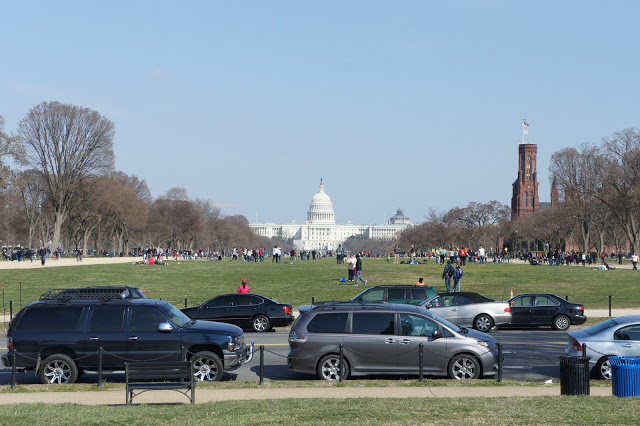
Thus our first day in DC came to a close. Next time I'll cover part 2 of Washington DC, including the National Air and Space Museum, the Lincoln Memorial, and a brief foray into Virginia.